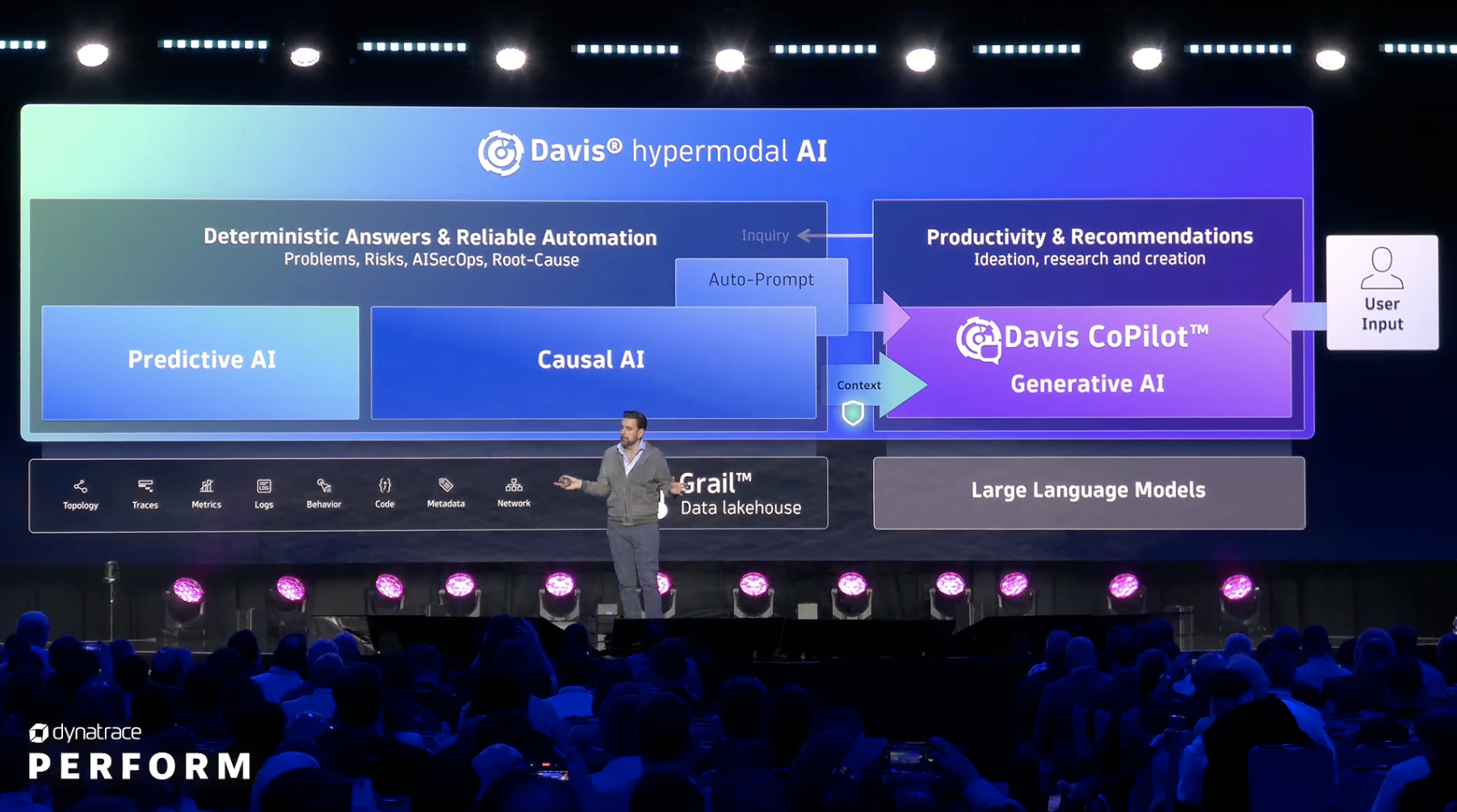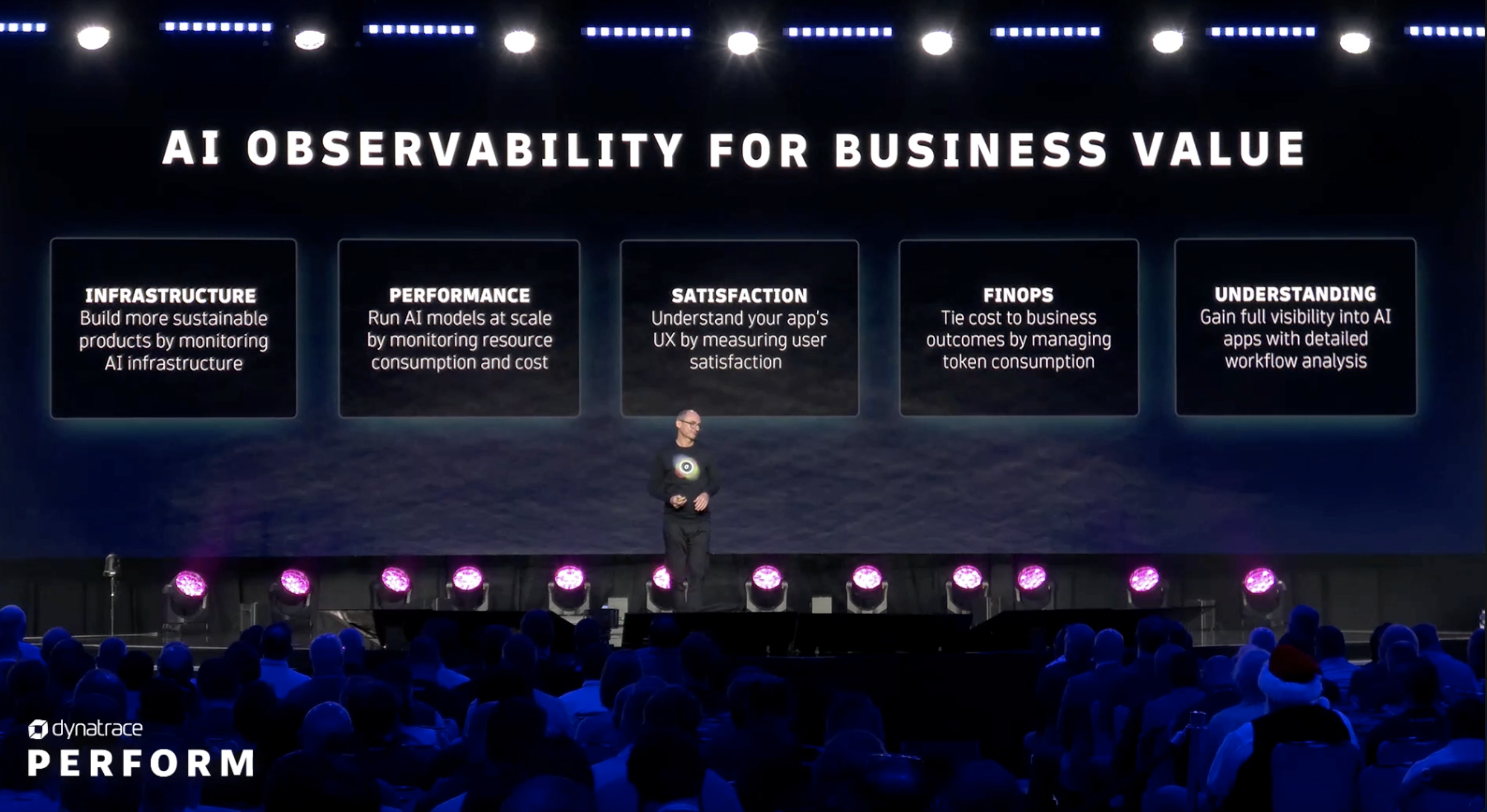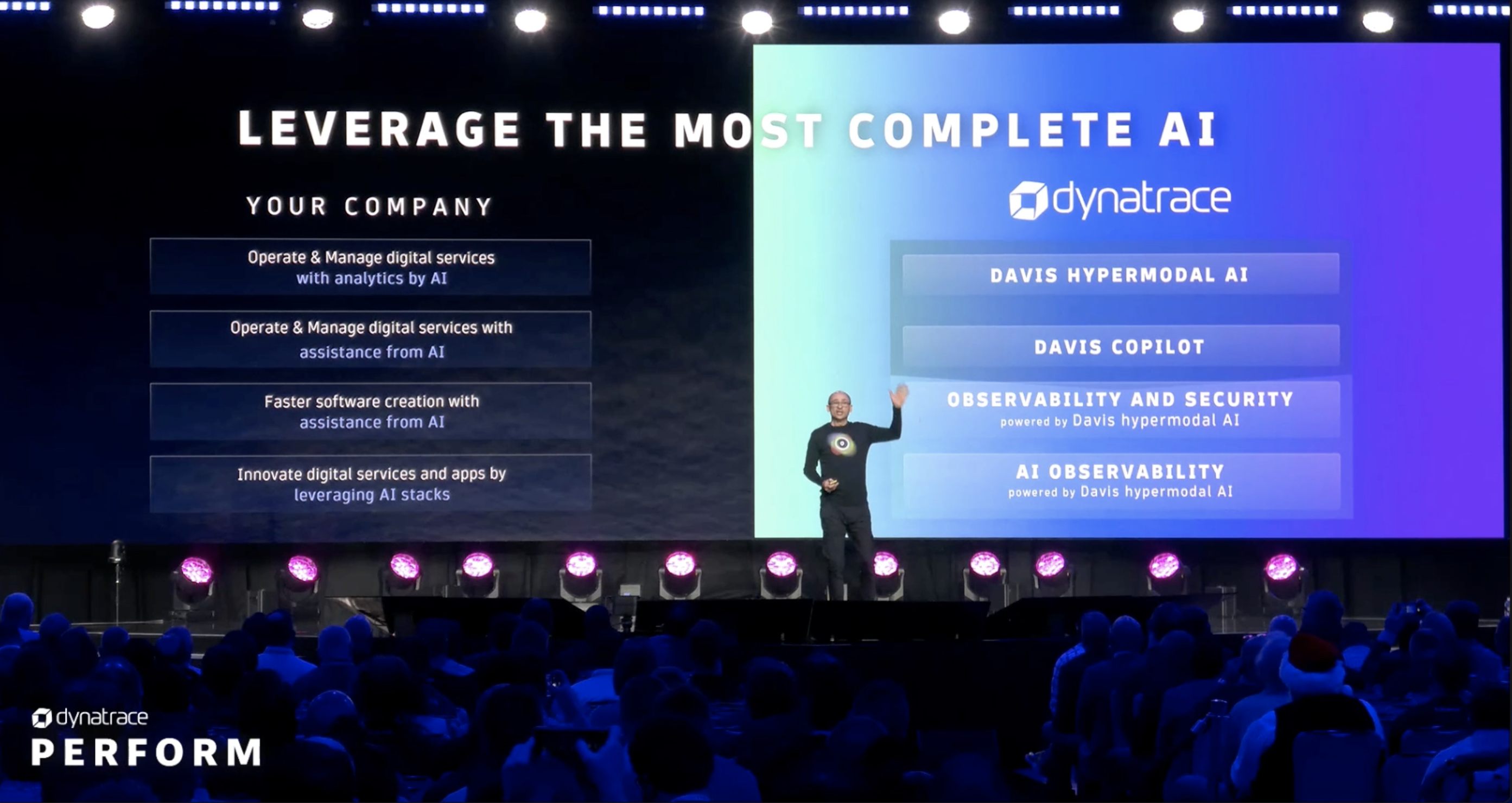Business and technology leaders are increasing their investments in AI to achieve business goals and improve operational efficiency. From generating new code and boosting developer productivity to finding the root cause of performance issues with ease, the benefits of AI are numerous. However, without observability, the AI wave—which has become more than just hype—comes with risks.
The first risk is not adopting AI at all. Organizations that miss out on implementing AI risk falling behind their competition in an age where software delivery speed, agility, and security are crucial success factors. But organizations must also be aware of the pitfalls of AI: security and compliance risks, biases, misinformation, and lack of insight into critical metrics (including availability, code development, infrastructure, databases, and more).
At the 2024 Dynatrace Perform conference in Las Vegas, Dynatrace chief technology strategist Alois Reitbauer joined founder and chief technology officer Bernd Greifeneder to discuss how organizations can mitigate their risk and embrace AI properly. Reitbauer delved into key use cases for Dynatrace hypermodal AI before Greifeneder introduced the platform’s new AI observability capability that will revolutionize how organizations can maximize value from their AI implementations.
Expanding hypermodal AI for all use cases with Davis CoPilot™

The Dynatrace composite approach to AI, known as hypermodal AI, enables organizations to extract the maximum ROI from their data efficiently and cost-effectively. Hypermodal AI combines predictive, causal, and generative AI so that organizations can not only predict behavior and identify root causes but also effortlessly store, query, and access their data using natural language and at a massive scale.
Moreover, with Davis CoPilot™, organizations can use generative AI to harness the full extent of hypermodal AI for every use case. “Every new question we ask comes with additional analysis, prediction models, and more,” Reitbauer said. “By packaging [these capabilities] into hypermodal AI, we are able to run deep custom analytics use cases in sixty seconds or less.”
Performance analytics
Dynatrace hypermodal AI empowers development teams to dig deep into database statements and remediate issues quickly. The first use case Reitbauer presented outlines a developer who hears from the database team that a problem might be occurring with the database. The developer opens a Dynatrace notebook, creates a CoPilot section, and asks for all the database statements executed over the past 72 hours using a natural language query.
In response, CoPilot delivers the data showing the variety of statements executed over the given timeframe. Armed with this data, the developer can then change the query to ask for the statements over a period (for example, the previous week). CoPilot then delivers the data, enabling the developer to easily identify regressions, increases, and more.
Security analytics
Davis CoPilot proactively mitigates risk by enabling security teams to validate hypotheses and hunt for threats before they impact the organization or end users. The second use case involves a security engineer who becomes aware of a new threat and wants to know if any of the organization’s systems might be affected. The engineer can efficiently access this data via a natural language query in a CoPilot Notebook: “Summarize all MITRE security events of the last 72 hours.”
In this example, there is a suspicious increase in scripting events. The key advantage of hypermodality is that users can frictionlessly switch from business events to logs to drill down further into their data. After updating the query to ask for log data, the engineer was able to identify attack attempts.
Experience analytics
Hypermodal AI also helps teams analyze issue reports, write scripts, and pinpoint root cause to maintain superior customer experiences. In the third use case, site reliability engineers (SREs) use Davis CoPilot to examine the number of problems over time to understand user impact. An SRE can translate a DQL query from a colleague into natural language, modify it, and examine the result. CoPilot efficiently provides valuable problem data so the SRE can then collaborate with the customer experience team to remediate the issue.
FinOps
The fourth use case illustrates how FinOps can also benefit from hypermodal AI. With as a significant priority for business and technology leaders, FinOps engineers can use CoPilot to understand the number of nodes on a Kubernetes cluster. Generative AI partners with predictive AI to deliver insights into the number of nodes for a specific cluster they will need in the future, thus improving efficiency while ensuring a frictionless customer experience.
Business workloads
The final use case considers an e-commerce business whose analyst team wants to understand the minimum daily number of orders they need to fulfill, in addition to predicting how much packaging they will need for an average week. First, they import their order data into the Dynatrace platform using the business events capability. From there, they can use predictive AI to forecast their daily workload. They can also modify the query to view their predicted workload on a weekly basis, forecast order amounts, and efficiently plan their packaging.
Mitigate risk for all use cases with AI observability

Reitbauer’s exploration of hypermodal AI and its variety of applicable use cases demonstrated that AI can deliver exponential value. As organizations consider the next AI services they will build, visibility into their implementations is critical to ensuring success.
At Perform 2024, Dynatrace announced the immediate availability of AI Observability, a capability that enables organizations to observe how their AI implementations are behaving. The complexity of modern cloud environments necessitates broad and deep observability into every layer of the tech stack to mitigate risk and deliver software quickly and securely. AI implementations are no exception.
AI Observability provides insights into all layers of the tech stack for which organizations might be using AI, including infrastructure, GPUs, semantics, vector databases, orchestration, and more. This also comes with context into the rest of your stack, with 700+ integrations out of the box: “[With AI observability,] you can observe not only the AI itself, but the applications and services that you bring to your customers,” Greifeneder said.
But contextual analytics don’t stop here. “AI Observability brings the ROI back to the business,” Greifeneder continued. “You can figure out if [your AI implementations] are bringing the value, customer experience, performance, and efficiency you need.”

AI observability is also a critical capability because of the increasing risk of duplicated code that comes with generative AI implementations. “Generated code becomes less maintainable. It poses more security risks due to its convenience,” said Greifeneder. “Dynatrace observes these applications that have been created with or augmented by generated code.” The Dynatrace composite approach to AI thus keeps applications secure while allowing organizations to reap the benefits of artificial intelligence in a variety of use cases.
Embrace AI completely, properly, and confidently with AI observability
As organizations navigate AI and explore how they can use the technology for their unique business goals, the Dynatrace platform empowers organizations to embrace AI properly. With its combination of predictive, causal, and generative AI, Dynatrace hypermodal AI enables cost-effective and efficient processes that promote collaboration, swift issue resolution before they reach end users, and the delivery of superior customer experiences.
For all Perform coverage, check out the Dynatrace Perform 2024 guide.




Looking for answers?
Start a new discussion or ask for help in our Q&A forum.
Go to forum